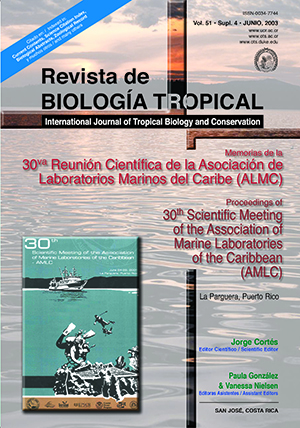Abstract
This research expresses the potential of the bacterial activity present in the organic extracts obtained from Penicillium sp., isolated from the esponge Ircinia felix. This activity was evaluated through agar diffusion test and Minimal Inhibitory Concentration (MIC). The susceptibility trials of organic fractions were carried out against Staphylococcus aureus, S. epidermidis, Bacillus cereus and B. subtilis. The use of the chromatographic techniques (CLV and TLC), permitted to obtain bioactive organic extracts of different polarities, of which only the EtOAc and MeOH fractions inhibited the growth of the bacteria used. Of the EtOAc fractionation, only fraction number 3 EtOAc/Hex presented greatest activity against the Gram-positive bacteria. Number 1 EtOAc/Hex fraction increased its activity against S. aureus (24 mm) and S. epidermidis (25 mm), which can be explained by the loss of possible antagonistic effect during the fractionation process. The CMI trials were carried out for the EtOAc number 1 subfraction against S. aureus, S. epidermidis, B. cereus and B. subtilis, wich was clinical interest, and shows the potential of this organic extract as antimicrobial agent.References
Alam, M., E.B. Gareth, M.B. Hossain & D. van der Helm. 1996. Isolation and structure of isoculmorin from the marine fungus Kallichroma tethys. J. Nat. Prod. 59: 454-456.
Bauer, A., W. Kirby, I. Sherris & M. Turk. 1966. Antibiotic susceptibility testing by standardized single disk method. Am. J. Clin. Pathol. 45: 493-496.
Coll, J.C. & B.F. Bowden. 1986. The aplication of vacuum liquid chromatography to the separation of terpene-mixture. J. Nat. Prod. 49: 934-936.
Delgado, A., S. Amich, S. Pietro & M. Salve. 1994. Laboratorio clínico de microbiología. McGraw Hill, Madrid. 593 p.
Domsch, K.H. & W. Gams. 1980. Compendium of soil fungi. Academic, London. 1985 p.
Fauci, A.S., E. Brauunwald, K.J. Isselbacher, J.D. Wilson, J.B. Martin, D.L. Kasper, & L. Longo. 1998. Harrison: Principios de Medicina Interna. McGraw-Hill, México D.F. 2941 p.
Faulkner, D.J. 1994. Production of bioactive metabolites by symbiotic microorganisms in marine sponges. J. Nat. Prod. 35: 22.
Hardman, J.G., L.E. Limbird, P.B. Molinoff, R.W. Ruddon & A.G. Gilman. 1996. Las bases farmacológicas de la terapéutica. McGraw-Hill, México DF. 1907 p.
Hay, M.E. & W. Fenical. 1996. Chemical ecology and marine biodiversity: Insight and products from the sea. Oceanography 9: 10-20.
Katzung, B. 1987. Farmacología básica clínica. El Manual Moderno, México, DF. 591 p.
Kobayashi, H., M. Naminoshi, T. Yoshimoto & T. Yokochit. 1996. A screening method for antimicotic and antifungal sustance using conidia of Pyricularia oryzae. Modification and application to tropical marine fungi. J. Antibio. 491: 573-879.
Köning, G.M. & A.D. Wright. 1995. Marine natural products research: current directions and future potencial. Plant. Med. 62: 193-211.
McCaffery, Y. and J. Endean. 1985. Antimicrobial activity of tropical and subtropical sponges. Mar. Biol. 89: 1-8.
Morales, T., J. Cubero, Z. Lanz, Y. Gómez-Guiñán & M.I. Segnini-Bravo. 2000. Actividad antimicrobiana de extractos orgánicos aislados de Aplysina fistularis (Demospongiae: Aplysinidae). Rev. Biol. Trop. 48 (Supl. 1): 199-206.
Pelletier, S.W. 1986. Separation of diterpenoid, alkaloid mixture using vacuum liquid chromatography. J. Nat. Prod. 49: 892-900.
Rios, J.L., M.C. Recio & A. Villar 1988. Screening methods for natural products with antimicrobial activity: a review of the literature. J. Ethnopharmacol. 23: 127-149.
Sheuer, P.J. 1986. Marine natural products. Chemical and biological perspectives. Academic, New York. 503 p.
Stainer, R.Y., E.A. Adelberg & J.I. Ingrahan. 1984. Microbiología. Reverte, Barcelona. 836 p.
Thakur, N.L. & A.C. Anil. 2000. Antibacterial activity of the sponge Ircinia ramosa. Importance of its surfaceassociated bacteria. J. Chem. Ecol. 26: 57-71.
Thompson, D.P. & C. Cannon. 1986. Toxicity of essential oils on toxigenic and nontoxigenic fungi. Bull. Eviron. Cont. Toxicol. 36: 527-532.
Toske, S.G., P.R. Jensen, C.A. Kauffmam & W. Fenical. 1998. Aspergillamides A and B: Modified cytotoxic tripeptides produced by a marine fungus of the genus Aspergillus. Tetrahedron 54: 13459-13466.
Touchstone, J. 1992. Practice of thin layer chromatography. Wiley, New York. 700 p.
##plugins.facebook.comentarios##

This work is licensed under a Creative Commons Attribution 4.0 International License.
Copyright (c) 2003 Revista de Biología Tropical


